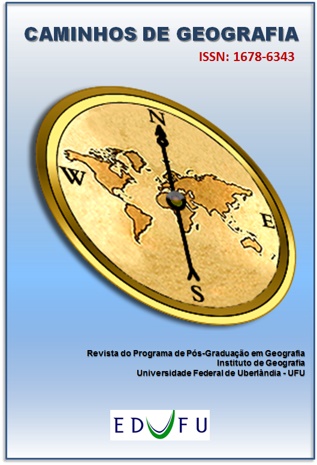TENDÊNCIA DE PRECIPITAÇÃO ANUAL E A OCORRÊNCIA DE EVENTOS EXTREMOS NA BACIA HIDROGRÁFICA DO RIO PIRAPÓ-PR ENTRE 1980 A 2017
DOI:
https://doi.org/10.14393/RCG238658744Palavras-chave:
Eventos extremos, Precipitação diária, TendênciaResumo
A presente pesquisa objetivou analisar o padrão de distribuição e possíveis tendências da precipitação média e da pluviosidade máxima em 24 horas anual na bacia do rio Pirapó-PR. Essa bacia está localizada no Terceiro Planalto Paranaense, entre as latitudes de 22º 30’ e 23º 30’ Sul e longitudes de 51º15’ e 52º15’ Oeste. Para a realização da pesquisa foram utilizados os totais pluviométricos diários de precipitação do período de 1980 a 2017 de 10 postos pluviométricos do Instituto das Águas do Paraná – SIH. Foi aplicada a estatística descritiva para os dados de pluviosidade dos 10 postos pluviométricos, utilizando-se os respectivos parâmetros: média, desvio padrão e coeficiente de variação. Por meio do teste não paramétrico de Mann-Kendall (1975), verificou-se possíveis tendências nas séries anuais da precipitação média anual e da precipitação máxima em 24 horas. Os resultados mostraram que há um aumento na distribuição da precipitação média anual do baixo para o alto curso da bacia, não sendo observado o mesmo padrão para a pluviosidade máxima diária semelhante. O teste de tendência demonstrou indícios de mudança no comportamento dos valores médios anuais de pluviosidade e máximos diários, porém não significativas.
Downloads
Downloads
Publicado
Edição
Seção
Licença
Copyright (c) 2022 Silvia Mioto, Hélio Silveira

Este trabalho está licenciado sob uma licença Creative Commons Attribution-NonCommercial-NoDerivatives 4.0 International License.
Autores que publicam nesta revista concordam com os seguintes termos: a) Autores mantém os direitos autorais e concedem à revista o direito de primeira publicação, com o trabalho licenciado sob a Creative Commons Atribuição-NãoComercial-SemDerivações 4.0 Internacional. b) Autores têm permissão e são estimulados a publicar e distribuir seu trabalho online (ex.: em repositórios institucionais ou na sua página pessoal), já que isso pode gerar alterações produtivas, bem como aumentar o impacto e a citação do trabalho publicado. c) Em virtude de aparecerem nesta revista de acesso público, os artigos são de uso gratuito, com atribuições próprias, em aplicações educacionais e não-comerciais.











